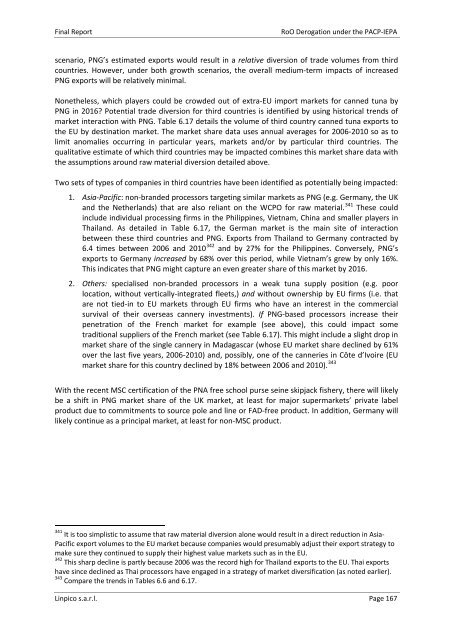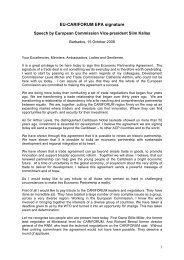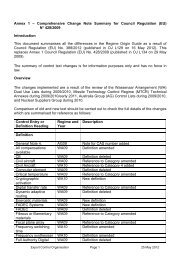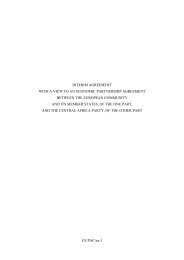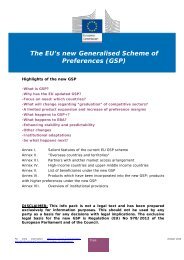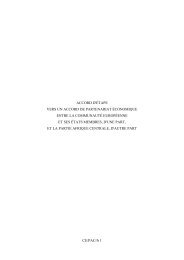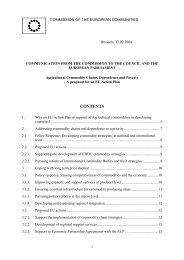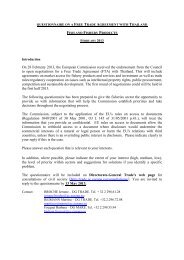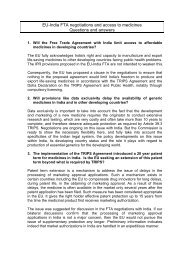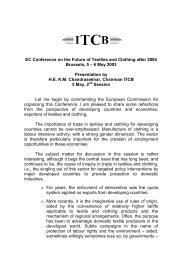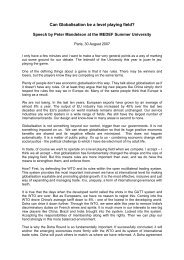Report on the Implementation of the derogation to ... - Trade Websites
Report on the Implementation of the derogation to ... - Trade Websites
Report on the Implementation of the derogation to ... - Trade Websites
You also want an ePaper? Increase the reach of your titles
YUMPU automatically turns print PDFs into web optimized ePapers that Google loves.
Final <str<strong>on</strong>g>Report</str<strong>on</strong>g><br />
RoO Derogati<strong>on</strong> under <strong>the</strong> PACP-IEPA<br />
scenario, PNG’s estimated exports would result in a relative diversi<strong>on</strong> <strong>of</strong> trade volumes from third<br />
countries. However, under both growth scenarios, <strong>the</strong> overall medium-term impacts <strong>of</strong> increased<br />
PNG exports will be relatively minimal.<br />
N<strong>on</strong>e<strong>the</strong>less, which players could be crowded out <strong>of</strong> extra-EU import markets for canned tuna by<br />
PNG in 2016 Potential trade diversi<strong>on</strong> for third countries is identified by using his<strong>to</strong>rical trends <strong>of</strong><br />
market interacti<strong>on</strong> with PNG. Table 6.17 details <strong>the</strong> volume <strong>of</strong> third country canned tuna exports <strong>to</strong><br />
<strong>the</strong> EU by destinati<strong>on</strong> market. The market share data uses annual averages for 2006-2010 so as <strong>to</strong><br />
limit anomalies occurring in particular years, markets and/or by particular third countries. The<br />
qualitative estimate <strong>of</strong> which third countries may be impacted combines this market share data with<br />
<strong>the</strong> assumpti<strong>on</strong>s around raw material diversi<strong>on</strong> detailed above.<br />
Two sets <strong>of</strong> types <strong>of</strong> companies in third countries have been identified as potentially being impacted:<br />
1. Asia-Pacific: n<strong>on</strong>-branded processors targeting similar markets as PNG (e.g. Germany, <strong>the</strong> UK<br />
and <strong>the</strong> Ne<strong>the</strong>rlands) that are also reliant <strong>on</strong> <strong>the</strong> WCPO for raw material. 341 These could<br />
include individual processing firms in <strong>the</strong> Philippines, Vietnam, China and smaller players in<br />
Thailand. As detailed in Table 6.17, <strong>the</strong> German market is <strong>the</strong> main site <strong>of</strong> interacti<strong>on</strong><br />
between <strong>the</strong>se third countries and PNG. Exports from Thailand <strong>to</strong> Germany c<strong>on</strong>tracted by<br />
6.4 times between 2006 and 2010 342 and by 27% for <strong>the</strong> Philippines. C<strong>on</strong>versely, PNG’s<br />
exports <strong>to</strong> Germany increased by 68% over this period, while Vietnam’s grew by <strong>on</strong>ly 16%.<br />
This indicates that PNG might capture an even greater share <strong>of</strong> this market by 2016.<br />
2. O<strong>the</strong>rs: specialised n<strong>on</strong>-branded processors in a weak tuna supply positi<strong>on</strong> (e.g. poor<br />
locati<strong>on</strong>, without vertically-integrated fleets,) and without ownership by EU firms (i.e. that<br />
are not tied-in <strong>to</strong> EU markets through EU firms who have an interest in <strong>the</strong> commercial<br />
survival <strong>of</strong> <strong>the</strong>ir overseas cannery investments). If PNG-based processors increase <strong>the</strong>ir<br />
penetrati<strong>on</strong> <strong>of</strong> <strong>the</strong> French market for example (see above), this could impact some<br />
traditi<strong>on</strong>al suppliers <strong>of</strong> <strong>the</strong> French market (see Table 6.17). This might include a slight drop in<br />
market share <strong>of</strong> <strong>the</strong> single cannery in Madagascar (whose EU market share declined by 61%<br />
over <strong>the</strong> last five years, 2006-2010) and, possibly, <strong>on</strong>e <strong>of</strong> <strong>the</strong> canneries in Côte d’Ivoire (EU<br />
343<br />
market share for this country declined by 18% between 2006 and 2010).<br />
With <strong>the</strong> recent MSC certificati<strong>on</strong> <strong>of</strong> <strong>the</strong> PNA free school purse seine skipjack fishery, <strong>the</strong>re will likely<br />
be a shift in PNG market share <strong>of</strong> <strong>the</strong> UK market, at least for major supermarkets’ private label<br />
product due <strong>to</strong> commitments <strong>to</strong> source pole and line or FAD-free product. In additi<strong>on</strong>, Germany will<br />
likely c<strong>on</strong>tinue as a principal market, at least for n<strong>on</strong>-MSC product.<br />
341 It is <strong>to</strong>o simplistic <strong>to</strong> assume that raw material diversi<strong>on</strong> al<strong>on</strong>e would result in a direct reducti<strong>on</strong> in Asia-<br />
Pacific export volumes <strong>to</strong> <strong>the</strong> EU market because companies would presumably adjust <strong>the</strong>ir export strategy <strong>to</strong><br />
make sure <strong>the</strong>y c<strong>on</strong>tinued <strong>to</strong> supply <strong>the</strong>ir highest value markets such as in <strong>the</strong> EU.<br />
342 This sharp decline is partly because 2006 was <strong>the</strong> record high for Thailand exports <strong>to</strong> <strong>the</strong> EU. Thai exports<br />
have since declined as Thai processors have engaged in a strategy <strong>of</strong> market diversificati<strong>on</strong> (as noted earlier).<br />
343 Compare <strong>the</strong> trends in Tables 6.6 and 6.17.<br />
Linpico s.a.r.l. Page 167


